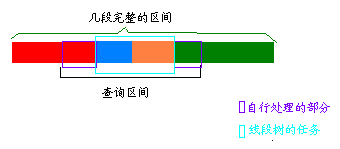poj 3368 Frequent values -Sparse-Table
| Time Limit: 2000MS | Memory Limit: 65536K | |
| Total Submissions: 16537 | Accepted: 5981 |
Description
You are given a sequence of n integers a1 , a2 , ... , an in non-decreasing order. In addition to that, you are given several queries consisting of indices i and j (1 ≤ i ≤ j ≤ n). For each query, determine the most frequent value among the integers ai , ... , aj.
Input
The input consists of several test cases. Each test case starts with a line containing two integers n and q (1 ≤ n, q ≤ 100000). The next line contains n integers a1 , ... , an (-100000 ≤ ai ≤ 100000, for each i ∈ {1, ..., n}) separated by spaces. You can assume that for each i ∈ {1, ..., n-1}: ai ≤ ai+1. The following q lines contain one query each, consisting of two integers i and j (1 ≤ i ≤ j ≤ n), which indicate the boundary indices for the
query.
The last test case is followed by a line containing a single 0.
Output
For each query, print one line with one integer: The number of occurrences of the most frequent value within the given range.
Sample Input
- -
Sample Output
Source
先讲一下题目大意,给出一个有n个数的不下降数列,和q个问题每个问题是求[a,b]中出现次数最多的数出现的次数,
有多组测试数据,当n = 0时测试结束
方法有多种,第一种直接暴力枚举,就不讲了
第二种用线段树,很多时候都不是完整的区间,怎么查?
左右两端不完整区间连续的个数是可以求出来的,这个就比较简单,记录一下每个区间开始的位置
,然后再弄个数组,记录第i个数属于的区间的新编号,如果a不是一个短的开始就就用下一个区间的
开始减去a (就把编号 + 1就是下一个区间的编号),结束部分就基本一样了
中间完整的区间就交给线段树查,最好是
把一个区间当成长度为1的线段,建树,查的时候就对应这个编号就行了。
由于我不想写,所以就不给代码了,可以在网上查查

第三种使用RMQ,反正又不会更新,再比较查询的时间复杂度,线段树的查询是O(log2N),而ST算法的查询时间O(1)(自行忽略
log函数执行的时间或者打表的时间),线段树建树的时间复杂度貌似是O(2N)左右(大约实际有效的节点是原数组的2
倍),ST算法的预处理时间是O(nlog2n)看起来差不多
ST算法的思路和上面差不多,两端单独处理,中间交给ST算法去查。
另外:
1.用位运算时一定要加上括号,位运算优先级很低,之前没在意,RE了几次
2.每次完成一轮计算该清0的清0,该还原的还原
Code
#include<iostream>
#include<cstdio>
#include<vector>
#include<cmath>
using namespace std;
typedef class MyData{
private:
MyData(int from,int end,int _count):from(from),end(end),_count(_count){}
public:
int from;
int end;
int _count;
MyData(){}
static MyData getNULL(){
return MyData(,,);
}
}MyData;
vector<MyData> list;
int a = -,b;
int *pos;
int count1;
int f[][];
int t;
int n,q;
void init(){
const int limit = list.size();
for(int i = ;i < limit;i++)
f[i][] = list[i]._count;
for(int j = ; ( << j) < limit;j++){
t = << j;
for(int i = ; i < limit && (i + t) < limit; i++){
f[i][j] = max(f[i][j - ], f[ i + ( << j - ) ][j - ]); //位运算优先级低!!!打括号
}
}
}
int main(){
while(true){
scanf("%d",&n);
if(n == ) break;
scanf("%d",&q);
pos = new int[(const int)(n + )];
for(int i = ;i <= n;i++){
scanf("%d",&b);
if(a == b){
list[list.size() - ]._count++;
pos[i] = pos[i - ];
}else{
if(!list.empty())
list[list.size() - ].end = i - ;
list.push_back(MyData::getNULL());
pos[i] = count1++;
list[list.size() - ].from = i;
list[list.size() - ]._count = ;
}
a = b;
}
list[list.size() - ].end = n;
init();
for(int i = ;i <= q;i++){
scanf("%d%d",&a,&b);
if(pos[a] == pos[b]){
printf("%d\n",b - a + );
continue;
}
if(pos[b] - pos[a] == ){
int result = max(list[pos[a]].end - a + ,b - list[pos[b]].from + );
printf("%d\n",result);
continue;
}
int ans = ;
ans = max(list[pos[a]].end-a+,b-list[pos[b]].from+);
b = pos[b] - ;
a = pos[a] + ;
int k = (int)(log((double)b-a+1.0)/log(2.0));
int t2 = max(f[a][k],f[b-(<<k)+][k]);
ans = max(ans,t2);
printf("%d\n",ans);
}
delete[] pos;
list.clear();
count1 = ;
a = -;
}
return ;
}
[后记]
附赠调试这道题时所用的对拍器、比较程序和数据生成器
cmp.cpp:
#include<iostream>
#include<cstdio>
#include<cstring>
using namespace std;
char buf1[];
char buf2[];
FILE *fin1;
FILE *fin2;
int main(int argc, char* argv[]){
fin1 = fopen(argv[],"r");
fin2 = fopen(argv[],"r");
while(!(feof(fin1))&&!(feof(fin2))){
fscanf(fin1,"%s",buf1);
fscanf(fin2,"%s",buf2);
if(strcmp(buf1, buf2) != ) return ;
}
if(feof(fin1) != feof(fin2)) return ;
return ;
}
md_fv.cpp:
#include<iostream>
#include<fstream>
#include<cstdlib>
#include<time.h>
using namespace std;
ofstream fout("fv.in");
int main(){ srand((unsigned)time(NULL)); int n = rand()% + ;
int q = rand()% + ; fout<<n<<" "<<q<<endl; int start = rand()% - ;
for(int i =; i<= n;i++){
start += rand()%;
fout<<start<<" ";
} fout<<endl;
for(int i = ;i < q;i++){
start = rand()%n + ;
int end = min(rand()%(n - start + ) + start,n);
fout<<start<<" "<<end<<endl;
} fout<<""<<endl;
return ;
}
test_fv.cpp:
#include<iostream>
#include<cstdlib>
#include<time.h>
using namespace std;
typedef bool boolean;
int statu;
boolean aFlag;
int main(){
system("g++ fv.cpp -o fv.exe");
system("g++ cmp.cpp -o cmp.exe");
system("g++ md_fv.cpp -o md_fv.exe");
system("g++ std.fv.cpp -o std.fv.exe");
for(int i = ;i < ;i++){
aFlag = true;
system("md_fv");
system("std.fv");
clock_t begin = clock();
statu = system("fv");
clock_t end = clock();
cout<<"测试数据#"<<i<<":";
if(statu != ){
cout<<"RuntimeError";
}else if(system("cmp fv1.out fv.out") != ){
cout<<"WrongAnswer";
}else{
cout<<"Accepted";
aFlag = false;
}
cout<<"\t\tTime:"<<(end - begin)<<"ms"<<endl;
if(aFlag){
system("pause");
}
}
return ;
}
poj 3368 Frequent values -Sparse-Table的更多相关文章
- POJ 3368 Frequent values 【ST表RMQ 维护区间频率最大值】
传送门:http://poj.org/problem?id=3368 Frequent values Time Limit: 2000MS Memory Limit: 65536K Total S ...
- poj 3368 Frequent values(RMQ)
/************************************************************ 题目: Frequent values(poj 3368) 链接: http ...
- POJ 3368 Frequent values (基础RMQ)
Frequent values Time Limit: 2000MS Memory Limit: 65536K Total Submissions: 14742 Accepted: 5354 ...
- poj 3368 Frequent values(段树)
Frequent values Time Limit: 2000MS Memory Limit: 65536K Total Submissions: 13516 Accepted: 4971 ...
- POJ 3368 Frequent values RMQ ST算法/线段树
Frequent values Time Limit: 2000MS Memory Lim ...
- POJ 3368 Frequent values(RMQ 求区间出现最多次数的数字的次数)
题目链接:http://poj.org/problem? id=3368 Description You are given a sequence of n integers a1 , a2 , .. ...
- poj 3368 Frequent values(RMQ)
题目:http://poj.org/problem?id=3368 题意:给定n个数,顺序为非下降,询问某个区间内的数出现最多的数的 出现次数.. 大白书上的 例题..算是RMQ变形了, 对 原数组重 ...
- (简单) POJ 3368 Frequent values,RMQ。
Description You are given a sequence of n integers a1 , a2 , ... , an in non-decreasing order. In ad ...
- POJ 3368 Frequent values(线段树区间合并)
[题目链接] http://poj.org/problem?id=3368 [题目大意] 有一个有序序列,要求区间查询出现次数最多的数 [题解] 维护每个区间左端点和右端点,以及左右的长度,还有区间的 ...
随机推荐
- 初次安装hive-2.1.0启动报错问题解决方法
首次安装hive-2.1.0,通过bin/hive登录hive shell命令行,报错如下: [hadoop@db03 hive-2.1.0]$ bin/hive which: no hbase in ...
- Bitfinex API
本文介绍Bitfinex APi Platform Status Get the current status of the platform. Maintenance periods last fo ...
- sed与grep正则
string editor 流编辑器 sed编辑器是一行一行的处理内容,正在处理的内容存放在缓冲区内,处理完后 按照选项的规定进行输出或者修改文件 option: -n 静默模式结合p可以只输出修 ...
- web 开发常见问题--GET POST 区别
首先,get和post是什么? --两种 HTTP 请求方法:GET 和 POST HTTP Request Methods GET.POST 专业名称是 HTTP Request Methods.但 ...
- gitlab启用https的配置
vim /etc/gitlab/gitlab.rb external_url 'https://101.101.101.63' #启用https,默认是http (改端口:external_ur ...
- dedecms利用addfields body在首页调用文章内容
开源程序比较好的一点是可以进行二次开发,比如ytkah想要开发一个专家出诊表的功能模块,如下图所示,每天的专家都不一样,可以用到内容模型,但是相对比较复杂:我们可以把每天的坐诊情况写成一篇文章再通过调 ...
- cube-ui的用法
.安装:npm install cube-ui -S .修改 .babelrc:(添加到plugins中去) { "plugins": [ ["transform-mod ...
- 使用PHP创建一个REST API(译)
最近API在网络领域有些风靡,明确的说是REST的影响力.这实在没什么好惊讶的,因为在任何编程语言中,消费REST API都是非常的容易.构建它也非常的简单,因为本质上你不会用到任何那些已存在很久的H ...
- [py]flask从0到1-模板/增删改查
flask知识点 1.后端渲染html到前端 render_template 2.后端获取前端数据 request.args.get 3.前端获取后端数据 模板 4.警示消息 flash {{ get ...
- [py][mx]xadmin注册切换主题功能和网站名称修改
注册主题 这里将基础的设置放到users模块 users/adminx.py from xadmin import views class BaseSetting(object): enable_th ...
